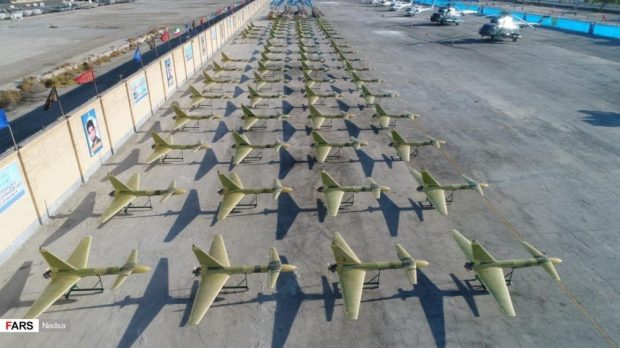Iran is preparing to supply Russia with hundreds of drone aircraft, including advanced models capable of firing missiles, the Biden administration said Monday, publicly revealing what U.S. officials say is a secret effort by Tehran to provide military assistance for Russia’s invasion of Ukraine.
Sullivan said Iran is also preparing to train the Russians on how to use the weapons, with initial training sessions set to begin as soon as this month.
“Our information indicates that the Iranian government is preparing to provide Russia with up to several hundred UAVs, including weapons-capable UAVs on an expedited timeline,” Sullivan told reporters in the White House briefing room.
“It’s unclear whether Iran has delivered any of these UAVs to Russia already,” Sullivan said, “but this is just one example of how Russia is looking to countries like Iran for capabilities.”
While Russia has its own extensive arsenal of drones, the arrival of Iranian aircraft could help Moscow replenish a key weapons system that suffered heavy losses during the four-month conflict. Surveillance UAVs play a crucial role in the targeting of enemy forces by artillery, and weaponized drones can hover over the battlefield for hours, launching missiles that can destroy tanks and other armored vehicles.
Receiving the UAVs is a “significant statement” about the limitations of Russian capabilities, said Frederick Kagan, director of the Critical Threats Project at the American Enterprise Institute.
There are various indications that Russian-backed forces are running out of precision weapons, something that the UAVs from Iran would change, he added.
“It’s difficult to evaluate what the effect will be, but it will clearly give the Russians more capability to conduct air attacks, presumably deeper into Ukrainian territory than they have now,” Kagan said.
Ukraine has used UAVs — many of them supplied by NATO countries such as Turkey — to destroy hundreds of Russian tanks and armored personnel carriers since the start of the invasion. Moscow, which now finds itself diplomatically isolated and under heavy economic sanctions, has struggled to replace some of its lost military hardware, while Ukraine is receiving billions of dollars’ worth of weapons, including state-of-the-art artillery systems from the United States.
“From our perspective, we will continue to do our part to help sustain the effective defense of Ukraine,” Sullivan said, “and to help the Ukrainians show that the Russian effort to try to wipe Ukraine off the map cannot succeed.”
Iran has emerged in recent years as a major manufacturer of unmanned aircraft. Among its military models is the Shahed-129, which closely resembles the U.S.-made Predator UAV used in military and counterterrorism operations overseas. Some military experts believe the Shahed-129 is a Predator clone, a reverse-engineering of a U.S. spy plane that crashed in Iran several years ago.
Iranian leaders have freely shared UAV systems with outside groups, most especially pro-Iran militias in Iraq, Syria and Yemen. Iranian-designed drones have been used to attack U.S. and allied military bases in the Middle East, as well as civilian targets such as oil refineries.
Over the years, Russia has been a key trading partner and occasional military ally to Iran. While Moscow joined the United States and European Union in backing the 2015 Iranian nuclear deal, it also fought alongside Iran in helping defend Syrian leader Bashar al-Assad — a key ally for both countries — during Syria’s 11-year civil war.
Source: The Washington Post

